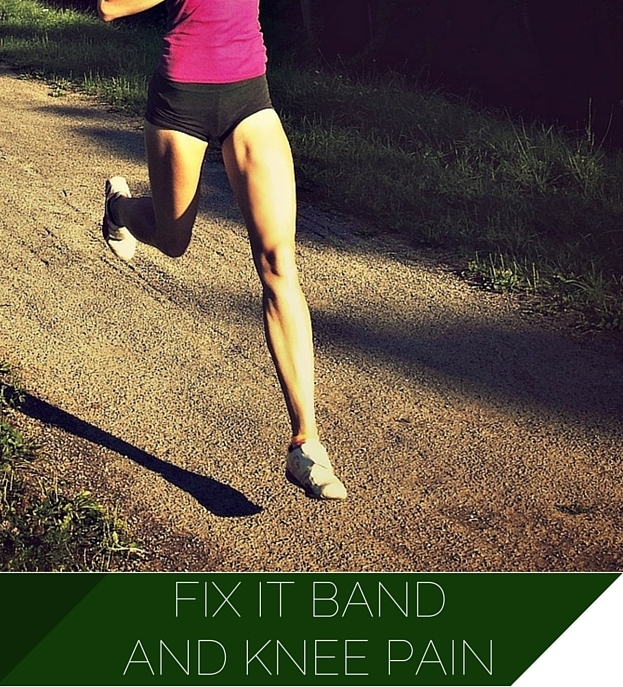If you are a heel strike runner who suffers from IT Band and knee pain, the source of your condition may be rooted in heel striking. Luckily, forefoot running has the mechanical capacity to relieve IT Band and knee pain.
How Runners Can Fix IT Band and Knee Pain
Forefoot running does more than just reduce ground reaction forces, protect the knees, and reduce heel pressures -it could also help with your IT Band.
How? Forefoot running does this by reducing knee abduction moments.
One of the main causes of ITBS in runners is high knee abduction moment -this is when the knee points inward (knocked knees) during stance, shown below:

In this case, the IT Band compresses the fat pad that lies beneath the band, causing radiating lateral knee pain.
In contrast, low knee abduction moments means that throughout the gait cycle, the knees point in the direction in which you are running (i.e. straight ahead) and do not ‘knock’ during stance. Unfortunately, researchers have given little thought to the affects of foot strike on IT Band and knee pain. Interestingly, one study revealed a link between foot strike and knee abduction moments.
Sterne et al., (2013) found that habitual forefoot runners had lower knee abduction moments compared to habitual heel strike runners, suggesting that forefoot running may prevent ITBS by allowing for better leg alignment. Moreover, most studies on IT band and knee pain involve heel strike runners and the suggested treatment options were hip strengthening exercises and stretching exercises. Yet, IT Band and knee pain remains common in joggers –most of which heel strike. Thus, the problem may be the foot strike technique.
How Forefoot Running Reduces Knee Abduction Moments
In forefoot running, the legs and feet interact more rapidly and stably with the ground which may limit knee abduction moments. This is primarily attributed to the forward position of the center of mass, knee bending, and ankle plantarflexion at touchdown. These components are similar to the mechanics of butt-kicking drills and if you have ever done butt-kicking drills, you would know that the knees never knock.
Because of the rapid ‘pop-off’ of the foot coupled with a flatter foot strike in general in forefoot running, stability of the foot is enhanced at touchdown and when the foot begins to bear the weight of the runner.
The video below illustrates what I mean:
Notice how the forefoot runner, Tirunesh Dibaba, looks like she’s doing butt-kicks? Her feet pop up off the ground in the up and down (vertical) direction and notice her knees are in a position to point more forward and not inwards?
If Dibaba had a high knee abduction moment, her knees would not point straight ahead at touchdown, rather they would point inwardly.
And again, unlike heel strike running, the flatter foot placement in forefoot running provides a more stable initial contact with the ground, which may also lower knee abduction moments during stance.
Tip
When forefoot running, keep your knees aligned apart from each other like Dibaba, and perceive your forefoot gait as a series of butt kicks -the feet should pop straight up-and-down. That strategy may work for you, however I found the following tip useful from Chi running:
keep your knees and feet pointed in the direction that you are running.
Very simple.
More From Run Forefoot:
Patellofemoral Pain Syndrome – Many runners suffer this dreaded injury, but many runners don’t know why. This article covers the main cause of knee injury in runners.
Achilles Heel – Found out why heel strike running is such a daunting task for the Achilles tendon, resulting in injury to the tendon.
Eccentric Exercises – We often hear about eccentric exercises, but you can achieve them just by running barefoot; find out how.
Forefoot Shoe Review – Read my review on the FeelMax Osma 2, an under-appreciated forefoot running shoes that is a great tool to help you mechanically run your best.
References:
Sterne et al. Joint kinetics rearfoot versus forefoot running: implications of switching technique. Med Sci Sports Exerc, 2014; 46(8);1578–1587.
Bretta Riches
BSc Neurobiology; MSc Biomechanics candidate, ultra minimalist runner & founder of RunForefoot. I was a heel striker, always injured. I was inspired by the great Tirunesh Dibaba to try forefoot running. Now, I'm injury free. This is why I launched Run Forefoot, to advocate the health & performance benefits of forefoot running and to raise awareness on the dangers of heel striking, because the world needs to know.
Latest posts by Bretta Riches (see all)
- Does Foot Strike Really Matter in Running? YES! - 17/04/2024
- Heel Lifts Increase Injury in Runners - 16/04/2024
- Are Minimalist Shoes Good for Seniors? YES! - 14/04/2024


Leave a Reply